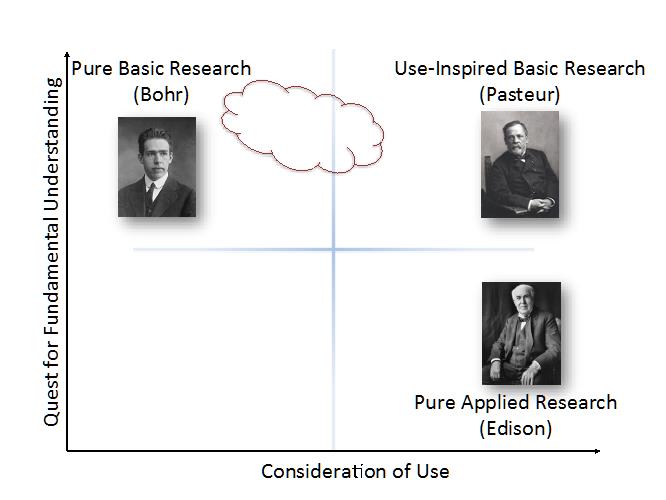Thinking beyond the 'Quadrant'
August 7, 2014
Ideas from the 1997 book by Donald Stokes, Pasteur's Quadrant, have become a popular means of describing the landscape of research and innovation. A key insight in the book was that scientific discovery is not a linear continuum that leads from basic science to applied science to transformative applications. Rather, Stokes invoked a two-dimensional picture along the axes of "quest for fundamental understanding" and "consideration of use," as illustrated in the figure.

He identified three of the quadrants with icons of discovery: Bohr for pure basic research; Edison for pure applied research; and Pasteur for use-inspired basic research. (A friend refers to the fourth quadrant as the "chia pet" quadrant because, like the chia pet, this section is for discoveries that have neither fundamental import nor practical application.)
Stokes refers to ideas that Vannevar Bush introduced in Science, the Endless Frontier, a report that called on the Nation to create the NSF. Bush said "basic research is the pacemaker of technological progress" and also argued that in an organization mixing applied and basic research, the latter would drive out the former. Stokes takes a different stand. He argues that basic science is better when its purpose is clear and that we should not neglect the use-inspired basic research that characterizes Pasteurâs quadrant. Some have morphed that argument into the position that the Nation should only fund use-inspired basic research. I think that is not what Stokes intended, and I believe that we must take a more nuanced view, even in an era of limited funding.
We should recognize, as did Stokes, that the plot is two-dimensional and that no organization sits at a single point in the space. (Perhaps we should even add additional dimensions to the space to encompass other aspects of the discovery enterprise.) I have drawn a cloud that might illustrate the space that the Directorate of Mathematical and Physical Sciences (MPS) occupies: a great deal of pure basic research with a significant dose of use-inspired basic research. Even within MPS, each division occupies its own characteristic area in the space. Other directorates within the Foundation sit in still different places. Considering various science-funding agencies, I conclude that NSF is the one that devotes the largest fraction of its resources to research in Bohr's quadrant.
It is alluring to think that all basic research should reside in Pasteur's quadrant. After all, looking for near term payoffs is a human trait. However, that view limits the range of our vision and risks missing out on those unforeseen discoveries that propel us, sooner or later, in completely unanticipated directions. General relativity was not inspired by the utility of the GPS, which could not function without it. Nor did the laser come from a desire to ring up groceries or perform eye surgery more easily. Similarly, early studies of green fluorescent protein did not flow from a desire to track cancer cells. Powerful discoveries and fundamental knowledge come from use-inspired basic research, but it is not the only game that we should play.
Many of us came to science driven by curiosity. It is a force that moves the scientific enterprise forward, and it sits at the heart of MPS and NSF. Even though the payoff of working in Bohr's quadrant can come decades after initial research, it is a way to exploit systematically the "heavy tailed" distribution of science in which rare events have profound consequences. In addition, NSF-funded research in Bohr's quadrant cultivates the next generation of talent that drives our science and technology forward. Times change and we refine our views, but the essential point that Vannevar Bush made after World War II remains presciently true: "basic research is the pacemaker of technological progress."
I look forward to sharing more news periodically and welcome your emailed comments at: mpsperspective@nsf.gov
Dr. F. Fleming Crim
NSF Assistant Director for Mathematical and Physical Sciences
Find more perspectives from the Assistant Director for Mathematical and Physical Sciences
